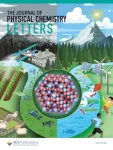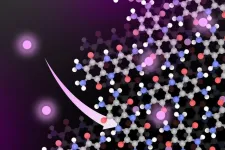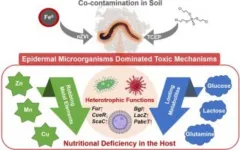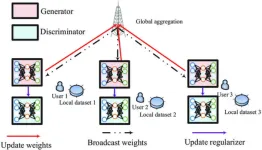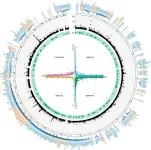(Press-News.org) (MEMPHIS, Tenn., January 18, 2024) St. Jude Children’s Research Hospital today announced a nearly $13 million investment toward a new research collaboration with scientists at Columbia University, Duke University and Stanford University to expand the understanding of G-protein coupled receptors (GPCR), which are vital proteins that impact human health and disease.
The collaborative research project is led by two St. Jude researchers, Scott Blanchard, Ph.D., and M. Madan Babu, Ph.D., who are working with Nobel laureate and Howard Hughes Medical Institute investigator Robert Lefkowitz, M.D., of Duke University; Jonathan Javitch, M.D., Ph.D., of Columbia University; and Georgios Skiniotis, Ph.D., and Alice Ting, Ph.D., both of Stanford University.
GPCRs have been linked to or implicated in more than 100 human diseases and disorders, and the GPCR Collaborative will use advanced methodologies, including time-resolved, single-molecule imaging, cryo-electron microscopy, proximity labeling, data science and other techniques to develop new strategies to treat a number of catastrophic pediatric diseases, including cancer. These approaches could lead to the development of better GPCR-targeting drugs.
“Ordinarily, there are few opportunities for teams from different institutions to come together for collaboration. Here, we’re bringing together our individual unique innovations and expertise so we can understand the mechanism by which GPCRs operate with the ultimate goal of using this information to identify and design more effective drugs,” said Blanchard. “This collaboration will help us define the principles underpinning the effectiveness of nature’s GPCR regulators and apply them to clinical therapies to increase their effectiveness, and hopefully reduce or eliminate side effects.”
As outlined in the 2022-2027 Strategic Plan, the St. Jude Research Collaboratives program is part of an overall effort by the institution to fund collaborative research addressing complex scientific problems with transformative potential for the diseases treated at St. Jude.
The St. Jude Research Collaboratives program was established to create multi-disciplinary teams consisting of St. Jude scientists and their peers at other institutions who can address specific challenges involved in the treatment of pediatric cancers and other catastrophic diseases. Proposing a collaborative requires a St. Jude principal investigator to assemble a team composed of leading scientists from St. Jude and other institutions. St. Jude funds approved projects.
“We understand that a team-oriented approach can increase the speed of research progress,” said James R. Downing, M.D., president and CEO of St. Jude. “The complexities of pediatric cancers and other life-threatening diseases demand collaboration among the best minds in their respective fields.”
Since 2017, six different Research Collaborative projects have been funded with an investment of more than $80 million with institutions including Princeton University, Washington University St. Louis, Dana Farber Cancer Institute, the Broad Institute of MIT/Harvard, Whitehead Institute for Biomedical Research of MIT, Boston Children’s Hospital/Harvard Medical School, Children’s Hospital of Pennsylvania, and the NIH/National Heart, Lung, and Blood Institute, The State University of New York at Buffalo, The Rockefeller University, University of Pennsylvania, and Massachusetts General Hospital. By 2027, St. Jude plans to support even more collaborations focused on unanswered needs in science and medicine which will increase total investment to $160 million.
“The St. Jude Research Collaboratives are designed to focus on problems with the greatest potential to transform understanding of the pediatric catastrophic diseases we treat,” said Charles W.M. Roberts M.D., Ph.D., executive vice president and director of the St. Jude Comprehensive Cancer Center, which developed and oversees the program. “The scientific progress we have seen to date across the collaboratives has been remarkable and we are looking forward to exceptional advances with the addition of the GPCR team.”
St. Jude Children's Research Hospital
St. Jude Children's Research Hospital is leading the way the world understands, treats and cures childhood cancer, sickle cell disease, and other life-threatening disorders. It is the only National Cancer Institute-designated Comprehensive Cancer Center devoted solely to children. Treatments developed at St. Jude have helped push the overall childhood cancer survival rate from 20% to 80% since the hospital opened more than 60 years ago. St. Jude shares the breakthroughs it makes to help doctors and researchers at local hospitals and cancer centers around the world improve the quality of treatment and care for even more children. To learn more, visit stjude.org, read St. Jude Progress blog, and follow St. Jude on social media at @stjuderesearch.
St. Jude Media Relations Contact
Michael Sheffield
Desk: (901) 595-0221
Cell: (901) 379-6072
Michael.Sheffield@stjude.org
END
St. Jude Children’s Research Hospital adds $13 million project to Research Collaboratives Program
The new initiative is part of a $160 million planned investment in similar research collaboratives to foster and speed up scientific breakthroughs
2024-01-18
ELSE PRESS RELEASES FROM THIS DATE:
Efficiently moving urea out of polluted water is coming to reality
2024-01-18
WPI Researchers have developed a material to remove urea from water and potentially convert it into hydrogen gas. By building these materials of nickel and cobalt atoms with carefully tailored electronic structures, the group has unlocked the potential to enable these transition metal oxides and hydroxides to selectively oxidize urea in an electrochemical reaction.
The study, led by Xiaowei Teng, the James H. Manning professor of Chemical Engineering at WPI, was recently published in the Journal of Physical Chemistry Letters and highlighted in the publication’s supplementary front cover.
The ...
Researchers awarded $2.7 million grant to develop the faba bean as a sustainable mid-Atlantic crop
2024-01-18
Consider the faba bean, also known as the fava bean or broad bean.
The bright-green legume has been enjoyed as a diet staple for thousands of years in Africa, Asia, and the Mediterranean. Just one cup of faba beans has 13 grams of protein — making it a better protein source than most other legumes — along with plenty of fiber, potassium, and iron. Plus, it’s a good cover crop that helps improve soil health, slow erosion, and control pests, disease, and weeds.
But you don’t often see it in the fields or on the menus in Virginia.
That’s why College of Agriculture and Life ...
Cobalt-free batteries could power cars of the future
2024-01-18
CAMBRIDGE, MA – Many electric vehicles are powered by batteries that contain cobalt — a metal that carries high financial, environmental, and social costs.
MIT researchers have now designed a battery material that could offer a more sustainable way to power electric cars. The new lithium-ion battery includes a cathode based on organic materials, instead of cobalt or nickel (another metal often used in lithium-ion batteries).
In a new study, the researchers showed that this material, which could be produced at much lower cost than cobalt-containing batteries, can conduct electricity at similar rates as cobalt batteries. The new battery also has comparable storage ...
New study reveals the impact of skin microorganisms on earthworm toxicity in polluted environments
2024-01-18
Epidermal microorganisms, vital in nutrient exchange between hosts and environments, have now been shown to play a key role in host toxicity through community changes. This research highlights how changes in the community of skin-based microbes correlate more significantly with earthworm toxicity than those in intestinal microorganisms, especially under combined soil contaminations.
A new study (https://doi.org/10.1016/j.eehl.2023.11.001) published in the journal Eco-Environment & Health, researchers from Zhejiang University revealed the crucial role of epidermal microorganisms in influencing earthworm toxicity under environmental stress, notably in conditions ...
Scientists, farmers and managers work together to avoid the decline of the little bustard, an endangered steppe bird
2024-01-18
The collaboration between scientists, farmers and managers is crucial to improve the protection of the little bustard, an endangered steppe-land bird in Spain due to human activity. The reduction of natural habitats, the increase in irrigation and the urbanization of the land have led to having less surface areas that guarantee the survival of this vulnerable species. An article published in the journal Biological Conservation reveals how cooperation between different actors is key to finding answers and avoiding the decline of the most threatened populations of the little bustard.
The study, a pioneer example of adaptative conservation, ...
Better wireless communication made possible through machine learning
2024-01-18
In today's increasingly interconnected world, high-quality communication has become more vital than ever. Accurately estimating the dynamic status of communication channels is a key factor in achieving this. Recently, a joint research team designed a new algorithm that offers high-level estimation accuracy and privacy protection with low computational and communication costs. This research was published Jan. 5 in Intelligent Computing, a Science Partner Journal.
This new algorithm uses a specially designed deep learning model for precise estimation and a federated learning framework ...
Study with over 11,000 individuals of African descent finds genetic variants linked to glaucoma
2024-01-18
Glaucoma is the leading cause of irreversible blindness around the globe, affecting up to 44 million people. Although people of African ancestry are most frequently and severely affected by this hereditary disease, its genetic underpinnings in this population have rarely been studied. Now, a team of investigators has published findings revealing previously unknown inherited genetic variants that contribute to primary open-angle glaucoma (POAG), the most common form of the disease. The study was based on the analysis of 11,275 individuals of African descent and is being published January 18, 2024, in Cell.
“Individuals with African ancestry are five times more likely to be affected ...
Economics: Sea level rises could cost EU and UK economies up to 872 billion Euros by 2100
2024-01-18
Damage caused by sea level rises could cost the EU and UK economies up to 872 billion Euros in total by the end of the century, according to a modelling study published in Scientific Reports.
Ignasi Cortés Arbués, Theodoros Chatzivasileiadis, Tatiana Filatova and colleagues modelled the potential economic impacts of sea level rises for 271 European regions by 2100 under a high emissions scenario (SSP5-RCP8.5) with no new coastal protection measures implemented after 2015. They combined ...
Genetics: Chewing over poor Mesolithic oral health
2024-01-18
Members of a hunter-gatherer group that lived in south-western Scandinavia during the Mesolithic era — approximately 10,000 years ago — may have been affected by tooth decay and gum disease, according to a study published in Scientific Reports.
Emrah Kırdök, Anders Götherström and colleagues sequenced the DNA found on three pieces of birch tar — a substance made from heated birch bark — that were excavated in the 1990s from Huseby Klev, Sweden and have been dated to between 9,890 ...
Mega-analysis identifies gene variants associated with glaucoma in people of African ancestry
2024-01-18
PHILADELPHIA— A new analysis focusing specifically on people of African ancestry identified three gene variants that may be contributing to this population’s susceptibility to developing and being blinded by glaucoma. People of African ancestry are five times as likely as others to develop glaucoma and up to 15 times as likely to be blinded by the condition, but the vast majority of research has used data from people of European ancestry. Led by researchers at the Perelman School of Medicine at the University ...
LAST 30 PRESS RELEASES:
Tracing the quick synthesis of an industrially important catalyst
New software sheds light on cancer’s hidden genetic networks
UT Health San Antonio awarded $3 million in CPRIT grants to bolster cancer research and prevention efforts in South Texas
Third symposium spotlights global challenge of new contaminants in China’s fight against pollution
From straw to soil harmony: International team reveals how biochar supercharges carbon-smart farming
Myeloma: How AI is redrawing the map of cancer care
Manhattan E. Charurat, Ph.D., MHS invested as the Homer and Martha Gudelsky Distinguished Professor in Medicine at the University of Maryland School of Medicine
Insilico Medicine’s Pharma.AI Q4 Winter Launch Recap: Revolutionizing drug discovery with cutting-edge AI innovations, accelerating the path to pharmaceutical superintelligence
Nanoplastics have diet-dependent impacts on digestive system health
Brain neuron death occurs throughout life and increases with age, a natural human protein drug may halt neuron death in Alzheimer’s disease
SPIE and CLP announce the recipients of the 2025 Advanced Photonics Young Innovator Award
Lessons from the Caldor Fire’s Christmas Valley ‘Miracle’
Ant societies rose by trading individual protection for collective power
Research reveals how ancient viral DNA shapes early embryonic development
A molecular gatekeeper that controls protein synthesis
New ‘cloaking device’ concept to shield sensitive tech from magnetic fields
Researchers show impact of mountain building and climate change on alpine biodiversity
Study models the transition from Neanderthals to modern humans in Europe
University of Phoenix College of Doctoral Studies releases white paper on AI-driven skilling to reduce burnout and restore worker autonomy
AIs fail at the game of visual “telephone”
The levers for a sustainable food system
Potential changes in US homelessness by ending federal support for housing first programs
Vulnerability of large language models to prompt injection when providing medical advice
Researchers develop new system for high-energy-density, long-life, multi-electron transfer bromine-based flow batteries
Ending federal support for housing first programs could increase U.S. homelessness by 5% in one year, new JAMA study finds
New research uncovers molecular ‘safety switch’ shielding cancers from immune attack
Bacteria resisting viral infection can still sink carbon to ocean floor
Younger biological age may increase depression risk in older women during COVID-19
Bharat Innovates 2026 National Basecamp Showcases India’s Most Promising Deep-Tech Ventures
Here’s what determines whether your income level rises or falls
[Press-News.org] St. Jude Children’s Research Hospital adds $13 million project to Research Collaboratives ProgramThe new initiative is part of a $160 million planned investment in similar research collaboratives to foster and speed up scientific breakthroughs


